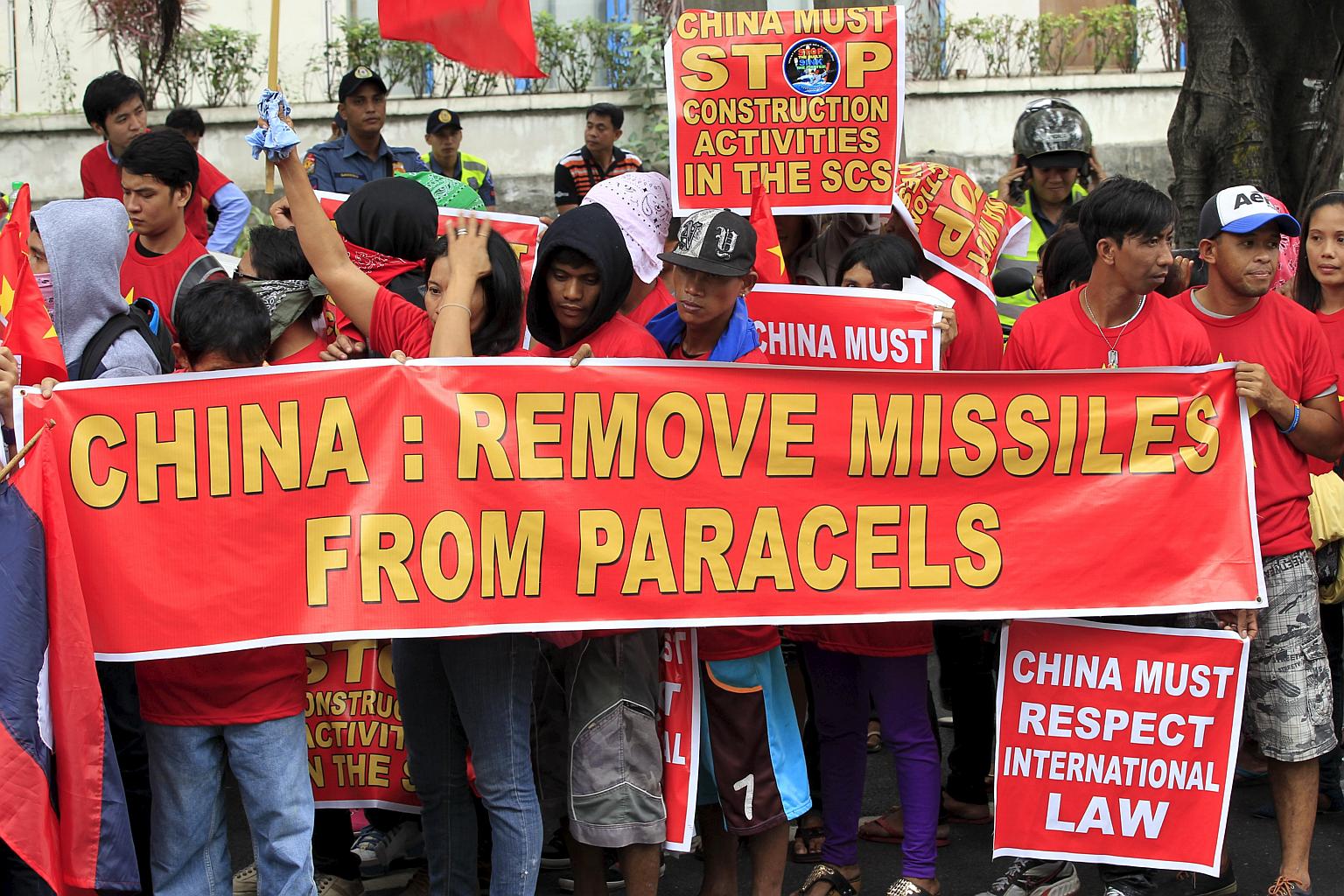Will China take the 'Cues'? : The Star columnist
Sign up now: Get insights on Asia's fast-moving developments

Protesters take part in a protest rally to denounce China's military buildup in the South China Sea in front of the Chinese Consulate in Manila, on Feb 25, 2016.
PHOTO: REUTERS
Follow topic:
Asean and China are set to meet in Manila this week on South China Sea. Will Beijing take up Singapore and Malaysia's suggestion for an expanded Code for Unplanned Encounters at Sea (Cues) ?
Mergawati Zulkafar
The Star/Asia News Network
The Asean Foreign Ministers retreat, an annual event normally held early in the year, is usually a quiet affair but there was something in the air at the recent meeting in Laos.
It was Vientiane's turn to host this year.
The retreat came at a time when tensions are rising in the South China Sea - a disputed maritime and territorial area claimed by Brunei, Malaysia, the Philippines, Vietnam, China and Taiwan.
Despite numerous statements and calls issued by Asean over the years and more recently at the US-Asean summit hosted by US President Barack Obama on the need to ease tensions in the area, China has continued to be aggressive in activities deemed as escalating tension.
So serious are the reported activities by China that the Vientiane retreat, according to officials, is seeing "fence sitters and doubters" beginning to understand the reality on the ground.
"Many foreign ministers spoke strongly on the issue and they were seriously concerned," said a diplomat.
This serious concern is reflected in Laos Foreign Minister Thongloun Sisoulith's statement issued to the media at the end of the two-day retreat in late February.
"The Ministers remained seriously concerned over recent and ongoing developments and took note of the concerns expressed by some Ministers on the land reclamations and escalation of activities in the area, which have eroded trust and confidence, increased tension and may undermine peace, security and stability in the region.
"The Ministers reaffirmed the importance of maintaining peace, security, stability, and freedom of navigation in and over-flight above the South China Sea," said the statement.
But as usual, there was no mention of China.
The South China Sea issue has become a contentious issue during Asean meetings and has "divided" Asean countries over the years with some members being seen as pro-China. Other members are wary of openly criticising China as Beijing is a major trade partner for Asean.
Asean and China have long been working on a binding code of conduct (CoC) to address numerous issues faced by claimant countries.
However, only a Declaration on the Conduct of Parties in the South China Sea (DoC) was finalised and signed in 2002.
The declaration reaffirms the parties' commitment to the United Nations Convention on the Law of the Sea and other international laws on state-to-state relations.
It also states that Asean members and China should resolve disputes "by peaceful means, without resorting to threat or use of force, through friendly consultations and negotiations".
An interesting development came about last week when Singapore Foreign Minister Vivian Balakrishnan announced China and Asean have agreed to explore a proposal of an expanded Code for Unplanned Encounters at Sea (Cues) that includes coastguard ships to prevent untoward clashes in the South China Sea.
Singapore is the country coordinator for China-Asean relations.
Dr Balakrishnan said he met his Chinese counterpart Wang Yi last Monday.
He said the key now is to introduce the code to make the sea safer and build confidence while China and Asean speed up talks for the Code of Conduct (CoC).
The Singapore proposal is not new.
In fact, Navy chief Laksamana Datuk Seri Ahmad Kamarulzaman Badaruddin had called for an expansion of Cues during the Maritime and Security and Coastal Surveillance conference in Kuala Lumpur last December.
Cues' scope builds on a code signed in 2014 by 21 members of the Western Pacific Naval Symposium that covers naval vessels and aircraft.
It is non-binding and includes China and eight Asean states.
Nonetheless Datukl Seri Ahmad Kamarulzaman's proposal was welcomed by many and is being seen by some officials as a step forward when Asean and China officials are still talking on the CoC.
The navy has already adopted Cues and wants it to be used by the region's coastguards which include the Malaysian Maritime Enforcement Agency.
It is understood that when Cues was raised by Singapore with Foreign Minister Wang Yi, China said it will study the matter.
"We know China would say it. It has always been their way of responding." said an official.
Still, that is still considered as progress for some parties in Asean. Progress perhaps since work on the CoC, started in 2012, is best described as slow.
"This is all part of the confidence building measure. This is to show to the international community that Asean and China are serious in finding solutions," insisted an official.
But will it defuse the tension in the area? Nobody is sure.
The issue will probably be raised again this week at the Asean-China joint working group (JWG) on South China Sea in Manila from Wednesday. This is the first meeting this year and the JWG is expected to continue the discussion relating to the implementation of the CoC.
"We are hoping that some small incremental but meaningful progress could be achieved this week," said a diplomat.

